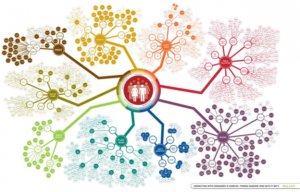Let’s Geek Out Over Data!
by Gay Bitter

I am a self-professed data geek, so Angela Struebing’s presentation on Multichannel Attribution at the August DMAW Lunch and Learn was right up my alley. Calculators were not provided but there was plenty of math during this great presentation!
So, what is multichannel attribution and why does it matter? This methodology provides a new tool to the campaign analysis process that allows you to more effectively give credit to the correct communications channel and touch point in a multichannel campaign. When used correctly, it enhances the ability to maximize marketing dollars spent.
This colorful infographic, The Mullen Marketing Ecosystem, is a somewhat overwhelming example of all of the communications channels potentially influencing your donors or customers.
Prospects don’t see a single message, so how do you figure out how to use your organization’s marketing dollars wisely? Each channel has its own metrics, each brings in donors or customers with varying lifetime values, and each has its own rate of response decay. Using attribution allows you to measure lift by channel and will help you determine which channels to continue to use and which to drop.
Current practices that many marketers use are Confirmed Response and Matchbacks. Flaws in these analysis tools are that they don’t factor in organic joins, follow-ups are likely given undue credit, and only touches with a reply device can be measured. Another practice, Fractional Allocation, is used in many iterations, but again, doesn’t provide true insight on the contribution that each marketing channel makes to a donation or response.
Using weighted multichannel attribution (yes, some math is required here!) gets you closer to seeing the value of each channel. Angela shared an example measuring the effectiveness of mail, email, telemarketing and cookie ads on a campaign. Using this method, she found that cookie ads were using 9% of the marketing budget, but contributed only 1% to donations, so this channel should be dropped. Mail used 66% of the budget and contributed 52% to contributions, so reducing mail quantity is a logical step. Telemarketing, which used 20% of the budget but contributed 33% to donations, should be increased.
So what are the pitfalls? You need to withhold prospects during testing. This gives you a baseline to measure against. That means you are missing potential donors; you can correct this by increasing your prospect universe on your next campaign. The good news? You only need to test once a year, and results for clients in similar industries can be used for others in the same industry, but be aware that results can differ based on geography as well as industry.
Here are a few best practices to consider before you engage in multichannel attribution for your organization.
- Make sure your offer and creative is consistent across channels – use the same imagery and message.
- Online interactions should be held to two clicks or engagement will drop.
- Contact prospects many times until you see diminishing returns or increased opt-outs.
- Plan your analytics and coding before you start.
Attribution is not a magic bullet that replaces all of your tried and true marketing analysis, so don’t throw out your old results. It’s just another tool in your toolbox. And, one last bit of advice from Angela, don’t get caught up in analysis paralysis. Know when to stop!
_________________________________________________________________________
 Gay Bitter is Vice President, Marketing at Relevate, a leading provider of comprehensive data marketing solutions. She can be reached at gbitter@relevategroup.com.
Gay Bitter is Vice President, Marketing at Relevate, a leading provider of comprehensive data marketing solutions. She can be reached at gbitter@relevategroup.com.
